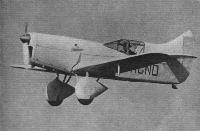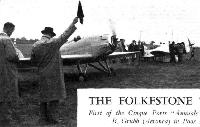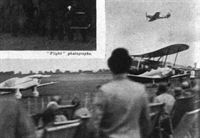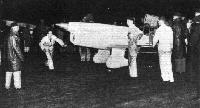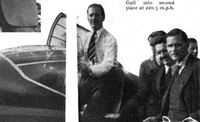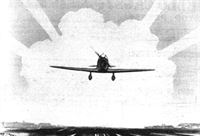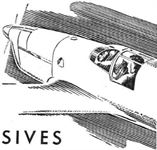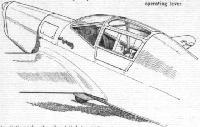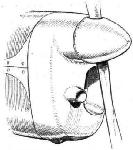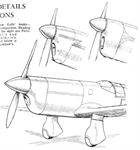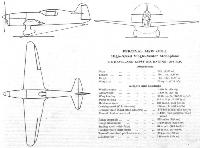
Percival. Самолеты семейства Gull
<...>
Следует также отметить самолет Mew Gull - одноместную гоночную модель с двигателем Napier Javelin 1a мощностью 165 л. с., ее первый полет состоялся в Грейвсенде в марте 1934 года. К июльской воздушной гонке на Королевский кубок на самолет был установлен двигатель Gipsy Six мощностью 200 л. с., и он развил скорость 307 км/ч. За первым самолетом, обозначенным как Type E.1, последовали четыре экземпляра совершенно новой конструкции - Type E.2. Они побили несколько рекордов в гонках и дальних перелетах, включая перелет, выполненный Алексом Хеншоу до мыса Доброй Надежды и обратно за 4 дня 10 часов 16 минут. Сохранившийся Mew Gull пережил войну и несколько аварий, был восстановлен до летного состояния и летает сегодня. Последняя модификация E.3H имела крыло и оперение меньшего размера, а также более узкий фюзеляж.
Описание:
- Percival. Самолеты семейства Gull
- Flight, March 1934
THE PERCIVAL "MEW GULL" - Flight, April 1936
MODERN LIGHT AIRCRAFT REVIEW - Flight, October 1938
British Sport and Training types - Flight, September 1939
To-day's Light Aeroplanes - Flight, November 1939
Britain's Civil Aircraft
Фотографии
-
Aeroplane Monthly 1983-02 / J.Silvester - Percival Aircraft 1933-1954 (2)
Регистрационный номер: G-AEXF [47] Percival Mew Gull G-AEXF photographed near Old Warden in June 1978 by AIK PORTRAITS
-
Мировая Авиация 139
Регистрационный номер: G-AEXF [47] Чрезвычайно сложный в пилотировании, особенно на взлете и посадке, когда обзор летчика вперед сильно ограничен, Percival P.6 Mew Gull является классическим гоночным самолетом своего времени. G-AEXF восстановлен до пригодного к полетам состояния.
-
Aeroplane Monthly 1999-09 / M.Vines - Photo Masterclass /Aviation photography/ (3)
Регистрационный номер: G-AEXF [47] A splendid sunset study of Desmond Penrose’s beautiful Percival Mew Gull. The light levels were so low that the author had to use shutter speeds of 1/30th and 1/60th of a second. It was only possible to shoot at such low speeds without suffering camera shake because the platform was a virtually vibrationless Cessna 182.
-
Air Enthusiast 2007-09 / A.Ord-Hume - Butterfly from Essex /Paper planes - projects/
Регистрационный номер: G-AEXF [47] Essex Aero was responsible for some of the many modifications carried out to Mew Gull G-AEXF.
-
Aeroplane Monthly 1978-09
Регистрационный номер: G-AEXF [47] AIR PORTRAIT'S picture, taken during a sortie from Old Warden on June 25, 1978, depicts a pair of fine vintage aeroplanes jointly owned by Tom Storey and Martin Barraclough. Nearest the camera is Duxford-based DH89 Dragon Rapide/Dominie G-AGTM/NF875, flown by Marlin Barraclough, whilst the newly-restored Percival Mew Gull G-AEXF, piloted by Brian Smith, is seen behind.
Другие самолёты на фотографии: De Havilland Dragon Rapide / Dominie / D.H.89 - Великобритания - 1934
-
Aeroplane Monthly 1998-09 / M.Oakey, T.Harmsworth - Vintage news
Регистрационный номер: G-AEXF [47] Legendary test- and racing pilot Alex Henshaw was reunited with the King’s Cup he won in 1938 - and the aeroplane he won it in, Mew Gull G-AEXF - at Old Warden’s Summer Air Show on July 5, 1998.
-
Flight 1934-05 / Flight
Регистрационный номер: G-ACND [17] PRINCE GEORGES ENTRY: The Percival "Mew Gull" which will be flown by Mr. Percival in the King's Cup Race.
-
Flight 1934-03 / Flight
Регистрационный номер: G-ACND [17] FAST TOURING: A glimpse of the "Mew Gull" flying past, with its designer at the controls.
The prototype Mew Gull, G-ACND, was originally powered by a Napier Javelin but later reengined with a 200 h.p. Gipsy Six. -
Flight 1935-05 / Flight
Регистрационный номер: G-ACND [17] The Percival "Mew Gull" entered for the Race by Prince George in 1934;
-
Flight 1934-03 / Flight
Регистрационный номер: G-ACND [17] This view of the machine indicate that in spite of the location of the cabin, the view diagonally forward is quite good.
-
Flight 1934-03 / Flight
Регистрационный номер: G-ACND [17] 200 M.P.H.: Mr. E. W. Percival demonstrated his latest machine, the "Mew Gull" (Napier "Javelin"), in a gale last week.
-
Aeroplane Monthly 1986-07 / Personal album
Регистрационный номер: G-ACND [17] Percival Mew Gull G-ACND is the subject of photo 2. First flown in March 1934, powered by a 165 h.p. Napier Javelin IA, the aircraft was fitted with a 200 h.p. D.H. Gipsy Six for the 1934 King's Cup race, held that July. G-ACND crashed near Angouleme in France in October 1935. Percival subsequently built a second, completely redesigned Mew Gull, also registered G-ACND.
-
Flight 1934-07 / Flight
Регистрационный номер: G-ACND [17] PRINCE GEORGES ENTRY: The Percival "Mew Gull" (Gipsy Six), although it averaged 191 m.p.h., was not fast enough to beat the handicappers.
-
Flight 1934-03 / Flight
Регистрационный номер: G-ACND [17] ROOM ENOUGH: In spite of the small size of the machine, there is room in the cabin for a large pilot (in this case Mr. Percival himself) wearing his parachute. The luggage locker is in the tail fairing.
-
Flight 1934-03 / Flight
Регистрационный номер: G-ACND [17] PREPARING FOR THE FIRST FLIGHT: Mr. Percival may be seen on the right, donning his parachute before taking the "Mew Gull" up in a gale.
-
Aeroplane Monthly 1980-02 / Gravesend /Gone but not forgotten/ (7)
Регистрационный номер: G-ACND [17] The original prototype Mew Gull, G-ACND, at Gravesend in March 1934.
-
Aeroplane Monthly 1983-02 / J.Silvester - Percival Aircraft 1933-1954 (2)
Регистрационный номер: G-ACND [17] Bearing the same registration letters, is the E.2 Mew Gull, an entirely new aeroplane that appeared in 1935.
-
Flight 1936-07 / Flight Advertisements
Регистрационный номер: G-ACND [17] The "Mew Gull" which won the Coupe Armand Esders Race in the hands of the Comte de Chateaubrun.
-
Aeroplane Monthly 1986-07 / Personal album
Регистрационный номер: G-ACND [17] The redesigned Percival Mew Gull, G-ACND is seen in front of the Gravesend control tower. Built in 1935, 'ND competed in that year’s King's Cup race, coming sixth with an average speed of 209 m.p.h. It was the first aircraft to exceed 200 m.p.h. in this event. It was burnt at Luton after the war.
-
Aeroplane Monthly 1979-12 / Heston /Gone but not forgotten/ (6)
The start of the Heston-Cardiff air race on September 23, 1935. The race was won by Edgar Percival in a Mew Gull, left, who covered the 121-mile course in 35min at an average speed of 208 m.p.h.
-
Aeroplane Monthly 1988-08 / A.Henshaw - Miles for the Cup! (2)
Регистрационный номер: G-ACND [17] Edgar Percival in Mew Gull G-ACND is flagged away by George Reynolds on the first day's racing. In the final he was placed sixth, averaging 209 m.p.h. for the whole course.
-
Flight 1935-09 / Flight
Регистрационный номер: G-ACND [17] First away on Friday the speedy Mew Gull; but on Saturday Capt. Percival had the arduous honour of starting last.
-
Flight 1936-07 / Flight
The Mew Gull at Shoreham on Friday.
-
Flight 1935-09 / Flight
Much in little, and quickly, too - one of the T.B. refuelling units supplying the Mew Gull.
-
Flight 1936-08 / Flight
Регистрационный номер: G-AEKL [17] Scratch and subscratch: Lord Patrick Crichton-Stuart (Hendy Hobo) awaits the fall of the flag in the final of the Folkestone Aero Trophy race, while Captain Percival prepares to start his Mew Gull, which had another ten minutes to wait.
Другие самолёты на фотографии: Hendy Hobo - Великобритания - 1929
-
Flight 1936-04 / Flight
Perhaps one of the best-known racing types in this country is the Percival Mew Gull (200 h.p. Gipsy Six)
-
Flight 1936-09 / Flight
Регистрационный номер: ZS-AHM [2] -
Flight 1936-10 / Flight
Capt. S. S. Halse giving his pillar-box-red Mew Gull an airing over a trio of visitors.
Другие самолёты на фотографии: De Havilland Puss Moth / D.H.80 - Великобритания - 1929
-
Flight 1935-09 / Flight
Регистрационный номер: G-ACND [17] OFFICIAL INTEREST. The Percival Mew Gull is the first aeroplane to exceed 200 m.p.h. in the King's Cup Air Race. The photograph shows it being examined at Hatfield with obvious interest by Lord Gorell, chairman of the Royal Aero Club, Sir Philip Cunlifle-Lister, Secretary of State for Air, and Lt. Col. Shelmerdine, Director-General of Civil Aviation.
-
Flight 1936-08 / Flight
GROOMING AT GRAVESEND: Capt. Percival superintends the preparation of some of his products for the Schlesinger Johannesburg Race. In the foreground is the 225 m.p.h. Mew Gull to be flown by Capt. Miller, which is receiving a Ratier variable pitch airscrew
-
Aeroplane Monthly 1983-02 / J.Silvester - Percival Aircraft 1933-1954 (2)
Регистрационный номер: G-AEKL [17] View of the Mew Gull G-AEKL. This aircraft was rebuilt after a ground collision with a Hawker Hart at Speke and was finally destroyed by German bombing of Lympne in June 1940.
-
Jane's All the World Aircraft 1938 / 03 - All the world's aeroplanes
Регистрационный номер: G-AEKL [17] The Percival "Mew Gull" Single-seat Cabin Monoplane (200 h.p. D.H. "Gipsy-Six" engine).
-
Flight 1939-09 / Flight
Регистрационный номер: G-AEKL [17] -
Flight 1937-01 / Flight
Регистрационный номер: G-AEKL [17] -
Air-Britain Archive 1980-03
Регистрационный номер: G-AEKL [17] Looking at the cover photo on Archive no.2, Phil Butler is quite certain that no building such as the one behind G-AEKL ever existed at Speke. This leads us to the conclusion that the photo must have been taken at Gravesend prior to the naming ceremony at Speke as the aircraft was damaged and pilot Campbell Black killed in a ground collision there. By chance we have unearthed the above photos of G-AEKL showing variations in colour scheme before and after the event at Speke. Here, at Hatfield 9.7.36
Другие самолёты на фотографии: British Aircraft BA.IV Double Eagle - Великобритания - 1936Miles Hawk / M.2 - Великобритания - 1932
-
Air-Britain Archive 1982-03
Регистрационный номер: G-AEKL [17] Vega Gull G-AEAB is seen in the centre of this group of Gulls being prepared for racing at Gravesend on 18.8.36. The far aircraft is unidentified but in the foreground is Mew Gull G-AEKL which won the King's Cup the following year.
Другие самолёты на фотографии: Percival Vega Gull / K.1 - Великобритания - 1935
-
Air-Britain Archive 1980-02
Регистрационный номер: G-AEKL [17] Campbell Black's tragic Miss Liverpool. The absence of spinners is unfortunate from aesthetic and aerodynamic viewpoints.
Included in the U.K. C of A Applications feature in this edition is Mew Gull G-AEKL. The photograph appears to have been taken at Speke where the aircraft was named "Miss Liverpool I" on 19.9.36. -
Aeroplane Monthly 1983-02 / J.Silvester - Percival Aircraft 1933-1954 (2)
Регистрационный номер: G-AEKL [17] View of the Mew Gull G-AEKL. This aircraft was rebuilt after a ground collision with a Hawker Hart at Speke and was finally destroyed by German bombing of Lympne in June 1940.
-
Flight 1937-09 / Flight
Регистрационный номер: G-AEKL [17] ZERO HOUR APPROACHES: The scene at Hatfield before the start of the King's Cup Race eliminating contest last Friday. Nearest the camera is Charles Gardner's blue 1936 model Percival Mew Gull which won the final at an average speed of 233.7 rn.p.h.
-
Air-Britain Archive 1980-03
Регистрационный номер: G-AEKL [17] Looking at the cover photo on Archive no.2, Phil Butler is quite certain that no building such as the one behind G-AEKL ever existed at Speke. This leads us to the conclusion that the photo must have been taken at Gravesend prior to the naming ceremony at Speke as the aircraft was damaged and pilot Campbell Black killed in a ground collision there. By chance we have unearthed the above photos of G-AEKL showing variations in colour scheme before and after the event at Speke. Here, at Hatfield again on 10.9.37 before winning the King's Cup at the then record speed of 233.7 mph.
-
Flight 1937-09 / Flight
Регистрационный номер: G-AEKL [17] Gardner's victorious Mew Gull being led in after the finish at Hatfield.
-
Flight 1937-09 / Flight Advertisements
Регистрационный номер: G-AEKL [17] -
Flight 1937-09 / Flight
Регистрационный номер: G-AEKL [17] Gardner's winning Mew Gull (Gipsy Six II).
-
Aeroplane Monthly 1980-09 / A.Henshaw - The Fastest Ever
Регистрационный номер: G-AEKL [17] The other Mew Gulls competing in 1938 King's Cup was G-AEKL, Giles Guthrie's mount. Aircraft was powered by the D.H. Gipsy Six II engine.
-
Flight 1938-07 / Flight
Регистрационный номер: G-AEKL [17] Another comparison: Henshaw’s Mew, which differs from Guthrie’s (see opposite), notably as regards spinner, cowling, spats and cockpit enclosure.
-
Aeroplane Monthly 1988-05 / Personal album. Civil
Регистрационный номер: G-AEKL [17] Percival Mew Gull G-AEKL, seen at Lympne in 1938. It was built in 1936 for Tom Campbell Black to race in that year's Schlesinger Race to Johannesburg, but before it could compete it was badly damaged on the ground at Speke when it collided with a Hawker Hart, killing Campbell Black. Rebuilt for Charles Gardner, 'KL won the 1937 King's Cup Race.
-
Мировая Авиация 211
Регистрационный номер: G-AEXF [47] Этот самолет был зарегистрирован своим южноафриканским владельцем в мае 1937 года как ZS-AHM и носил имя "The Golden City". Ныне Mew Gull, переживший Вторую мировую войну, имеет регистрацию G-AEXF. Он был восстановлен до летного состояния и ныне сдан в аренду в коллекцию "Shuttleworth".
-
Aeroplane Monthly 1980-09 / A.Henshaw - The Fastest Ever
Регистрационный номер: G-AEXF [47] The author's Mew Gull 40 years on. Very little of the original structure remains, and G-AEXF is basically a new aeroplane. AIR PORTRAITS took the photograph near Old Warden in June 1978.
-
Aeroplane Monthly 1978-09
Регистрационный номер: G-AEXF [47] Brian Smith poses Tom Storey and Martin Barraclough’s Percival Mew Gull for Air Portraits over Old Warden on June 25, 1978
-
Aeroplane Monthly 1978-08 / News Spotlight
Регистрационный номер: G-AEXF [47] Tom Storey and Martin Barraclough's beautiful newly-restored Mew Gull G-AEXF made its public debut at Old Warden on June 25, 1978, when it was flown by Brian Smith.
-
Aeroplane Monthly 1980-09 / A.Henshaw - The Fastest Ever
Регистрационный номер: G-AEXF [47] G-AEXF in its original configuration
-
Aeroplane Monthly 1989-03 / A.Henshaw - Henshaw's Cape dash
Регистрационный номер: G-AEXF [47] Henshaw's Percival Mew Gull at the time he purchased it, in 1937.
-
Flight 1937-09 / Flight
Регистрационный номер: G-AEXF [47] Three Percival Mew Gulls - two with Series II Gipsy Six engines - are entered. This view is of Alex Henshaw's machine with Series I engine.
-
Aeroplane Monthly 1983-02 / J.Silvester - Percival Aircraft 1933-1954 (2)
Регистрационный номер: G-AEXF [47] Mr. A. Henshaw taxies his Mew Gull (a la racehorse) up to the line at Ronaldsway. He made fastest time in this machine, which was flown (with v.p. airscrew) by Major Miller in the South Africa race.
Mew Gull, seen here in its original form before modifications by Jack Cross of Essex Aero turned it into a different aeroplane. -
Aeroplane Monthly 1978-05 / News Spotlight
Регистрационный номер: G-AEXF [47] As we went to press Tom Storey’s beautiful Percival Mew Gull, G-AEXF was expected to make its first flight after protracted restoration work. 'EXF was originally supplied to Maj A. M. Miller of South Africa as ZS-AHM The Golden City. Owned and flown in England by Alex Henshaw, it won the 1937 Folkestone Trophy and the 1938 King's Cup Race. In 1939 it made a record return flight to the Cape in 4 days 10hr 16min.
-
Flight 1938-07 / Flight
Регистрационный номер: G-AEXF [47] Another comparison: Henshaw’s Mew, which differs from Guthrie’s (see opposite), notably as regards spinner, cowling, spats and cockpit enclosure.
-
Flight 1938-06 / Flight Advertisements
Регистрационный номер: G-AEXF [47] ESSEX AERO LTD. were responsible for the preparation and modification made to MR. ALEX HENSHAW'S "MEW GULL" WINNER OF THIS YEAR S KING S CUP AIR RACE at the record average speed of 236.25 m.p.h.
-
Aeroplane Monthly 1990-08 / M.Oakey - Grapevine
Регистрационный номер: G-AEXF [47] The Mew seen at closer quarters at the Shuttleworth Collection's Gipsy Air Day on June 3, 1990, where a brake snag limited it to taxying.
-
Aeroplane Monthly 1989-03 / M.Oakey - Grapevine
Регистрационный номер: G-AEXF [47] Percival Mew Gull G-AEXF at Old Warden for engine runs on January 21, 1989, at the end of a major rebuild by Skysport Engineering. It has been restored to the configuration in which Alex Henshaw flew it to Cape Town and back in just 4-2 days in 1939.
-
Flight 1939-02 / Flight
Регистрационный номер: G-AEXF [47] This photograph of the Mew Gull being refuelled at Libreville (French Equatorial Africa) on the outward journey was collected by Mr. Henshaw on the homeward flight and brought back by him to London.
-
Aeroplane Monthly 1989-03 / A.Henshaw - Henshaw's Cape dash
Регистрационный номер: G-AEXF [47] Another refuelling stop on the outbound journey, this time at Mossamedes. The author is splattered with blood from a torn finger snagged on a small retaining hook on a side window.
-
Aeroplane Monthly 1989-03 / A.Henshaw - Henshaw's Cape dash
Регистрационный номер: G-AEXF [47] Henshaw's Mew Gull during full-power running of the D.H. Gipsy Six Series II engine at Gravesend in February 1939.
-
Aeroplane Monthly 1991-02 / Percival Mew Gull G-AEXF /Preservation Profile/
Регистрационный номер: G-AEXF [47] The much-modified Mew Gull flown by Peter Clifford in the 1954 Goodyear Race at Shoreham.
-
Aeroplane Monthly 1990-10 / Personal album. Civil
Регистрационный номер: G-AEXF [47] Percival Mew Gull G-AEXF at Croydon in the mid-Fifties. During the war the former Alex Henshaw Gull was hidden away in France and was brought back to this country after the war by Hugh Scrope. Throughout the Fifties the Mew was extensively raced by subsequent owners Nat Somers and Fred Dunkerley.
-
Aeroplane Monthly 1990-04 / 1990 UK Aircraft Collections and Museums Guide
Регистрационный номер: G-AEXF [47] Percival Mew Gull G-AEXF in its Cape record configuration (the first time round) at Hendon in 1951. It now resides at old Warden.
-
Aeroplane Monthly 1980-09 / A.Henshaw - The Fastest Ever
Регистрационный номер: G-AEXF [47] G-AEXF after its first stage of modification for the King's Cup race. It was further modified for the author's Cape record flight of February 1939.
-
Aeroplane Monthly 1986-07 / Personal album
Регистрационный номер: G-AEXF [47] Percival Mew Gull G-AEXF is one of the most famous British racing aeroplanes of all. This photograph, probably taken in 1937, shows the Mew after early modifications made by Essex Aero during that year.
-
Aeroplane Monthly 1991-06 / Personal album. Civil
Регистрационный номер: G-AEXF [47] Percival Mew Gull G-AEXF at Blackbushe on arrival from Lyon on July 2, 1950, a journey made by the grace of God and Doug Bianchi - actually Hugh Scrope was the pilot! The 3 1/4 hr flight was the aircraft’s first since 1939. There was no luxury of a local test flight and it was Scrope’s first flight in the racer. Doug Bianchi’s view was that if the pilot was going to crash it was better to do it landing at home! The Mew is seen here still in its Cape record configuration.
-
Aeroplane Monthly 1990-08 / M.Oakey - Grapevine
Регистрационный номер: G-AEXF [47] Percival Mew Gull G-AEXF takes off past a distinctive Old Warden backdrop on the afternoon of June 19, 1990, on its first flight since restoration to Cape configuration. Owner Desmond Penrose was at the controls.
-
Flight 1938-07 / Flight
Регистрационный номер: G-AEXF [47] The same aircraft pictured shortly after winning the 1938 King's Cup race, at Hatfield on July 2. Modifications for the race including fitting a 225 h.p. D.H. Gipsy Six R, smaller wheels, one-piece perspex screen, lowering the cabin roof by 4in and reshaping the bottom fuselage decking.
-
Aeroplane Monthly 1980-09 / A.Henshaw - The Fastest Ever
Регистрационный номер: G-AEXF [47] The author with the coveted King’s Cup and G-AEXF winning the race at Hatfield on July 2, 1938.
-
Aeroplane Monthly 1980-09 / A.Henshaw - The Fastest Ever
Регистрационный номер: G-AEXF [47] The author lands at Hatfield after winning the race at an average speed of 236-25 m.p.h. His Mew Gull was powered by the 230 h.p. D.H. Gipsy Six R engine.
-
Aeroplane Monthly 1991-02 / Percival Mew Gull G-AEXF /Preservation Profile/
Регистрационный номер: G-AEXF [47] PHOTO LINK'S plate was taken in October 1990 shortly after the Mew's restoration to its Cape flight configuration.
-
Aeroplane Monthly 1990-12 / M.Oakey - Grapevine
Регистрационный номер: G-AEXF [47] Unique formation No 2: a trio of famous racers, in the shape of Miles Hawk Speed Six G-ADGP, Percival Mew Gull G-AEXF and D.H.88 Comet G-ACSS Grosvenor House fly past - in the other direction - also at Old Warden on October 7, 1990.
Другие самолёты на фотографии: De Havilland Comet / D.H.88 - Великобритания - 1934Miles Hawk / M.2 - Великобритания - 1932
-
Flight 1939-02 / Flight
Регистрационный номер: G-AEXF [47] The Mew Gull escorted to the Gravesend tarmac at the end of the great flight. Proud Mr. Henshaw, Senior, can just be seen behind the rudder.
-
Aeroplane Monthly 1989-03 / A.Henshaw - Henshaw's Cape dash
Регистрационный номер: G-AEXF [47] Henshaw photographed a few minutes earlier, taxying in after landing at Gravesend after the final 1,200-mile leg from the Cape.
-
Aeroplane Monthly 1980-02 / Gravesend /Gone but not forgotten/ (7)
Регистрационный номер: G-AEXF [47] Alex Henshaw in Mew Gull G-AEXF after his return flight to the Cape, February 9, 1939.
-
Aeroplane Monthly 1989-03 / A.Henshaw - Henshaw's Cape dash
Регистрационный номер: G-AEXF [47] The author taxies in at Gravesend a moment before the upper photograph was taken.
-
Aeroplane Monthly 1989-03 / A.Henshaw - Henshaw's Cape dash
Регистрационный номер: G-AEXF [47] Jack Cross lifts the author from the Mew Gull on his arrival at Gravesend just before 1400hr on February 9, 1939, amidst shocked onlookers.
-
Aeroplane Monthly 1989-03 / A.Henshaw - Henshaw's Cape dash
Регистрационный номер: G-AEXF [47] Two photographs of the author taken immediately after landing at the Cape. All records have been broken, but he is now faced with the return flight a little more than 27hr later. Having landed at Cape Town at 1859hr on the Monday evening he took off again for the first return stage at 2218hr the following day.
-
Aeroplane Monthly 1980-09 / A.Henshaw - The Fastest Ever
Регистрационный номер: G-AEXF [47] -
Aeroplane Monthly 1980-09 / A.Henshaw - The Fastest Ever
Регистрационный номер: G-AEXF [47] Last minute adjustments being made to the author's Mew Gull at Hatfield on the day of the big race.
-
Flight 1937-09 / Flight
Регистрационный номер: G-AFAA [7] Capt. Percival's Mew Gull, which finished third in the final and which made the fastest actual speed on both days.
-
Aeroplane Monthly 1980-09 / A.Henshaw - The Fastest Ever
Регистрационный номер: G-AFAA [7] The other Mew Gulls competing in 1938 King's Cup was G-AFAA, flown by Capt Edgar Percival. Aircraft was powered by the D.H. Gipsy Six II engine.
-
Aeroplane Monthly 1983-02 / J.Silvester - Percival Aircraft 1933-1954 (2)
Регистрационный номер: G-AFAA [7] The first and last. In the foreground, G-AFAA, the last Mew Gull built; in the background the prototype Q.6 G-AEYE, seen at Hayes in 1939.
Другие самолёты на фотографии: Percival Petrel / Q.6 - Великобритания - 1937
-
Flight 1938-10 / Flight
Регистрационный номер: G-AFAA [7] Fast, yet comparatively docile, the Percival Mew Gull can carry a useful load over long distances. Variations of the type have won the King’s Cup in the last two successive years.
-
Aeroplane Monthly 1983-02 / J.Silvester - Percival Aircraft 1933-1954 (2)
Регистрационный номер: G-AFAA [7] The sixth and last Mew Gull, G-AFAA, in which Percival competed in the 1937 King's Cup air race. Though he did not win, his speed of 238.7 m.p. h. was the fastest for the course.
Designated Type E.3H it had a smaller wing, smaller tail areas, a narrower fuselage and was powered by a 205 h.p. D.H. Gipsy Six Series II engine. Built in 1937 the aircraft was burnt at Luton on July 7, 1945. -
Flight 1939-07 / Flight
Регистрационный номер: G-AFAA [7] ELECTRIC: Last week, meteorologically speaking, was one of cold, warm and lukewarm fronts, tendencies to local thunder, and other such odd mixtures which keep C.A.G. aspirants on the ground and raise sailplane pilots to new altitude records. Capt. Percival in his Mew Gull, and Flight's chief photographer, went in search of pictorial possibilities. Here is one of them.
-
Flight 1939-07 / Flight
Inspiring aerial impression by John Yoxall, Flight’s chief photographer. The aircraft is Capt. Edgar Percival’s Mew Gull.
-
Aeroplane Monthly 1980-09 / A.Henshaw - The Fastest Ever
Capt. Percival’s Mew Gull - which finished sixth - from an unusual viewpoint.
Edgar Percival landing at Hatfield, having averaged 234 m.p.h. for the 1,012-mile course. -
Flight 1938-07 / Flight
Variety: Sqn. Ldr. Gillan’s Hurricane flies over an International Air Freight Condor; on the left is Capt. Percival’s Mew Gull, and in front of the Condor is a Magister.
Другие самолёты на фотографии: Curtiss Condor 18 - США - 1929Hawker Hurricane - Великобритания - 1935Miles Magister / M.14 - Великобритания - 1937
-
Aeroplane Monthly 1983-02 / J.Silvester - Percival Aircraft 1933-1954 (2)
The oxide-finished E.3H Mew Gull, later G-AFAA, in early 1937.
-
Aeroplane Monthly 1991-02 / Percival Mew Gull G-AEXF /Preservation Profile/
Регистрационный номер: ZS-AHM [2] The subject of this profile was originally delivered to A. M. Miller as ZS-AHM and named Die Goudstad.
-
Aeroplane Monthly 1980-02 / Gravesend /Gone but not forgotten/ (7)
Регистрационный номер: ZS-AHO [3] The South African-registered Mew Gull ZS-AHO, built for Captain S. S. Haise.
-
Aeroplane Monthly 1977-06 / J.Griffin - Portsmouth Airport 1932-1973
Регистрационный номер: ZS-AHO [3] No 13. Airspeed Envoy G-AENA in company with Percival Mew Gull ZS-AHO, Baragwanath at Portsmouth on the eve of the Portsmouth to Johannesburg Race in September 1936.
Другие самолёты на фотографии: Airspeed Envoy / AS.6 - Великобритания - 1934
-
Flight 1936-11 / Flight
The Percival Mew Gull illustrated has one of the new Series II Gipsy Six engines.
-
Flight 1936-10 / Flight
Swinging the Ratier airscrew of Major Miller's Mew Gull. Note the impressive spinner covering the pitch-operating electric motor.
-
Flight 1937-09 / Flight
Family affair: Miss Pearl Henshaw, "Pop" and Alex, clean down their Mew Gull at Baldonnell.
-
Aeroplane Monthly 1986-04 / Grapevine
Регистрационный номер: G-AEXF [47] Percival Mew Gull G-AEXF in the workshops of Skysport Engineering on February 26, 1986. Skysport are to restore the Gull for new owner Desmond Penrose.
-
Flight 1938-07 / Flight
Giles Guthrie shows some visitors round the Mew Gull.
-
Flight 1937-07 / Flight
RECIPROCITY: Mr. G. de Havilland, the winner, does the handshaking act with Mr. Henshaw (in the Mew Gull) for the newspaper photographers' benefit at Cardiff.
-
Flight 1938-07 / Flight
Giles Guthrie, who brought his Mew Gull into second place at 220.5 m.p.h.
-
Flight 1937-09 / Flight
Mr. Gardner, photographed at the start.
-
Flight 1937-07 / Flight
Alex Henshaw, with the Mew Gull, added another line to his long list of "fastest times" by averaging 208 m.p.h. He finished sixth.
-
Aeroplane Monthly 1980-09 / A.Henshaw - The Fastest Ever
Регистрационный номер: G-AEXF [47] The author having a stretch: the cockpit was anything but roomy.
-
Aeroplane Monthly 1989-03 / A.Henshaw - Henshaw's Cape dash
The author, then aged 24, seated in the Mew Gull at Gravesend in February 1939. Note how close the instrument panel is to the pilot's face. The panel was moved backwards in order to accommodate a larger fuel tank.
-
Flight 1939-02 / Flight
HENSHAW TRIUMPHANT: Alex Henshaw before the start of his Cape record attempt last week-end. Flying his little King’s-Cup-winning Percival Mew Gull (Gipsy Six R) he did Gravesend - Cape Town in 39 1/2 hours, against F/O Clouston’s 45 hours. He is due to return as we go to press, and next week we hope to deal fully with his achievement.
-
Flight 1939-12 / Flight
200 M.P.H. UPWARDS: Young Alex Henshaw, after a long innings as a private owner, has put his experience to good purpose by joining the test piloting staff of the Supermarine branch of Armstrong Whitworths. With team mates like Pickering and Quill he has landed a job any young man would give his boots for.
-
Flight 1939-06 / Flight
Second and third in the main race - Mr. Alex Henshaw (above) and Capt. E. W. Percival - who each flew a Mew Gull.
-
Flight 1936-09 / Flight
Major Miller, who is flying No.1 Mew Gull in the race, and Capt. E. W. Percival, who has more machines in the race than any other constructor.
-
Aeroplane Monthly 1984-04 / A.Ord-Hume - Edgar Wikner Percival
Регистрационный номер: G-AFAA [7] Edgar Percival, brilliant designer of the Mew Gull, in familiar pose in his own Gull, G-AFAA, before the race. Timekeeper George Reynolds looks on.
-
Flight 1936-07 / Flight
Snugly ensconced in the cockpit of his pet Mew Gull - Capt. Percival in his complete racing outfit, the two major features of which are a trilby and the well-known smile.
-
Flight 1935-09 / Flight
The Face at the Window is that of Capt. E. W. Percival (and why shouldn't one wear a respectable hat in a 215 m.p.h. aeroplane?)
-
Flight 1935-09 / Flight
Interior view of the cabin of H.R.H. the Duke of Kent's Mew Gull, which Capt. Percival flew into sixth place at 208.91 m.p.h. On the left side of the cabin floor is the flap operating lever.
-
Flight 1936-09 / Flight
Arrangements for the comfort and safeguarding of a Mew Gull pilot. Not the least interesting feature the Irvin chair-type parachute.
-
Flight 1937-09 / Flight
The instruments and controls of Gardner's Mew Gull. The majority of instruments, unless otherwise indicated, are Smith's :- (1) Reid and Sigrist turn-and-bank indicator, (2) Airspeed indicator. (3) Altimeter - another is concealed by the card at the foot of the panel. (4) and (5) Air intake temperature switch and indicator. (6) Fuel gauge - another is hidden on the extreme left of the panel. (7) Clock. (8) Air intake and flame-trap control. (9) Airscrew pitch control. (10) Tail trimmer. (11) Compass. (12) Stop watches (13) Throttle and altitude controls. (14) Ignition switches. (15) Oil pressure. (16) Sperry directional gyro. (17) Boost pressure gauge. (18) Engine rev. indicator. The flap control, not visible in this view, is below the throttle controls.
-
Aeroplane Monthly 1991-09 / M.Oakey - Grapevine
Регистрационный номер: G-AEXF [47] The sad remains of Percival Mew Gull G-AEXF near Old Warden on July 17, 1991. Miraculously, pilot Desmond Penrose escaped uninjured.
-
Aeroplane Monthly 1989-03 / A.Henshaw - Henshaw's Cape dash
Регистрационный номер: G-AEXF [47] Night take-off from Gao - by Michael Turner
"... and with a murmured prayer slowly opened the throttle. As expected, the moment the engine revved up nothing could be seen for the swirling clouds of dust, which easily found its way into the cockpit filling the inside with choking grit and that strange, inimitable smell as well.” -
Flight 1937-09 / Flight
Venturi tube on a swivelling mounting on Henshaw's Mew Gull.
-
Flight 1935-09 / Flight
Exterior view of the cabin of H.R.H. the Duke of Kent's Mew Gull, which Capt. Percival flew into sixth place at 208.91 m.p.h.
-
Flight 1935-07 / Flight
The modified empennage on the Percival "Mew Gull."
-
Flight 1937-09 / Flight
The air intake in the cowling of Capt. Percival's Mew Gull, near the airscrew, gives a boosting effect.
-
Flight 1938-07 / Flight
Mew Gulls’ beaks - in comparison. Reading on the right are Percival's and Guthrie's, and below is Henshaw’s.
-
Flight 1935-09 / Flight
The news that Lord Wakefield has presented to the R.Ae.C. a cheque tor L250 to be awarded to Capt E. W Percival as a special Prize in recognition of his performance in the King's Cup race lends interest to this general arrangement drawing and data - not generally known - of the Mew Gull. It will be recalled that, although he was not placed in the Final, Capt. Percival averaged 208.91 m.p.h. over the 350 miles and made the fastest lap of the day with a speed of 211.2 m.p.h. The machine was entered for the race by H.R.H. The Duke of Kent
Тип фотографий
- Все фото (132)
- Цветные фото (6)
- Ч/б фото (110)
- Кабина (3)
- Обломки (1)
- Рисунки, схемы (12)






